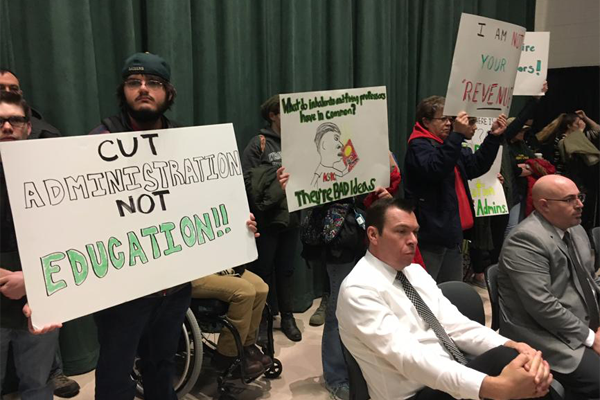
Excerpt from the Dayton Daily News
Wright State University’s financial woes are so deep the school may not fully recover for two decades, according to a report obtained by this news organization.
The report was created by the WSU administration and filed with a fact-finder as part of ongoing contract negotiations with the faculty union. It paints a vivid picture of Wright State’s budget trouble and shares certain details publicly for the first time.
“It will take WSU more than 20 years to get back to the financial position it was in just six years ago,” the report states.
The report comes even as Wright State administrators and trustees have said in recent months that the university has “turned a corner” financially.
“As has been known publicly and thoroughly reported, Wright State University has been navigating out of a serious financial challenge and continues to make the tough choices it must to return the university to long-term fiscal sustainability, so it can meet the needs of its students and be the university Dayton and Ohio need it to be,” spokesman Seth Bauguess said via email.
Martin Kich, president of the Wright State chapter of the Association of American University Professors, said he was “astonished” the administration released the report and said several of the financial issues mentioned in it were exaggerated.
“I’m dumbfounded that they bothered to put that out,” Kich said. “It basically echoes the arguments they made to the fact finder which we thought were hyperbolic… I don’t see what point it serves.”
- View Wright State's Fact-Finding Post-Hearing Brief (PDF)
- Related: DDN: Wright State fall tuition revenue comes in millions under budget estimates
Wright State is trying to recover from a financial crisis that forced trustees to slash more than $30.8 million from the school’s budget in 2017. Those cuts ended up not being enough, though, and the school ended up reducing spending by around $53 million in fiscal year 2018.
In June, trustees approved a FY 2019 budget that projected another $10-million decline in revenue for Wright State.
The report cites previous years of overspending and a decrease in donations, noting contributions to WSU declined by more than half from 2011 to 2015, “putting its $7.2 million total below local Wittenberg University, which is about one-sixth its size.”
The report also goes so far as to say Wright State has been in such financial trouble that it “literally stopped taking out the trash except for one day per week.”
Doug Fecher, chairman of the WSU board of trustees, declined to comment on the report, instead referring to the statement from the university.
Though Wright State president Cheryl Schrader and other administrators have said the university would likely avoid fiscal watch, the report states WSU is “now on the cusp of fiscal watch.”
The state measures every public college’s fiscal health with something called a “Senate Bill 6 score,” an annual rating of 0 to 5.
Half the score is based on the school’s reserve fund, essentially how much cash the school has in the bank. The other two factors include a viability score, which calculates the university’s ability to service its debts, and an income ratio, which measures the school’s change in net assets, according to the FY 2018 WSU budget.
Any school that falls below a 1.75 two years in a row is put on notice. Wright State projected its score last year was a .8, meaning one more year below a 1.75 would put the school on fiscal watch.
Under fiscal watch, the WSU trustees and administration would have to adopt a financial recovery plan with an eye toward ending the status of fiscal watch within three years, according to state law. They would be required to produce forecasts and plans for getting the school’s finances back on track, and if the administration did not do this, the chancellor of the Ohio Department of Higher Education could appoint someone to make those decisions for the university.
Wright State’s .8 score for 2017 was the “lowest score of any public university of its size since Senate Bill 6 passed in the 1990s,” according to the report.
“In other words, its financial circumstance is more at risk than any other comparable public university in Ohio has ever been,” the report states.
The report was submitted by the university to make a case for its stance on contract negotiations. It states a fact-finder has recommended a wage freeze for the faculty.
The administration has offered faculty a three-year contract with no raises and reduced health benefits, Kich said. A final fact-finder’s report on negotiations is due out at the end of October and the faculty union has threatened to strike if a deal is not reached.
The report states the AAUP-WSU has asked for an 8 percent raise over the next two years despite the university’s financial issues. In order to finance such a raise, the university would have to consider closing part of campus, eliminating athletics or transferring the Boonshoft School of Medicine to another Ohio university.
But, the union does not expect to get any raise, Kich said, and was just using the raise request as a negotiating tactic. The administration and fact-finder are aware of this, he said.

